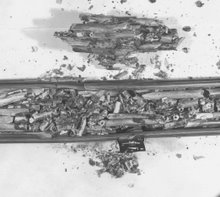GETR means General Electric Test Reactor.
TR-1 means Test Reactor 1 license issued by Atomic Energy Commission (AEC) for GETR.
APED-4454 is a report, Atomic Power Equipment Department for the GETR single plate burnout.
WTR means Westinghouse Testing Reactor.
TR-2 means Test Reactor 2 license issued by AEC for WTR.
WTR-49 is a report issued by Westinghouse for WTR for single element meltdown.
I'm working on this. WTR had more engineering but GETR had more good luck! I'll discuss GETR first. GE burned out Element F-21 and did not even know it at the time, but I must disclose that Mr. Paul Zeanah, the GETR analyst during 1960, is the person who suggested that I inspect F-21 when I was troubleshooting the abrasion situation.
I selected the following set of 13 slides from the report of my work (APED 4454, Class III) and it has the handwritten suggestions by Dorothy Crosier, the GE editor. Please click on the following slides for enlargement. Then use your back arrow to move to the next slide.












 I used the Bernath equation for calculating the burnout heat flux. GE had published a burnout correlation for this fuel when they were paid to design the Engineering Test Reactor (ETR). That GE correlation is useless (just plain wrong) and I also did not reference it when I proposed the power level increase for the GETR.
I used the Bernath equation for calculating the burnout heat flux. GE had published a burnout correlation for this fuel when they were paid to design the Engineering Test Reactor (ETR). That GE correlation is useless (just plain wrong) and I also did not reference it when I proposed the power level increase for the GETR. Next, let's look at the meltdown of one fuel element at the Westinghouse Testing Reactor (WTR). Following are five slides from report WTR-49. Les Kornblith, my boss at GE, gave me this report when he left GE to manage reactor inspectors at the AEC. (Les was a good man, hired into GE by Sam Untermyer, and Les did well with the feds.)





I'll add more slides from WTR-49 and further discussion at my leisure. For now, I'll say that GE had a far superior plant arrangement and they spent a lot less money. In Simpson's book, Nuclear Power from Underseas to Outer Space, he reports in 1995 that further cleanup from the meltdown of the single fuel element will be expensive, "...during the cleanup process following the accident thousands of gallons of water were used that became contaminated with radioactive water. Some of the water has contaminated the soil and groundwater. This cleanup must be completed before final decommissioning can be completed and will be quite costly."





I'll add more slides from WTR-49 and further discussion at my leisure. For now, I'll say that GE had a far superior plant arrangement and they spent a lot less money. In Simpson's book, Nuclear Power from Underseas to Outer Space, he reports in 1995 that further cleanup from the meltdown of the single fuel element will be expensive, "...during the cleanup process following the accident thousands of gallons of water were used that became contaminated with radioactive water. Some of the water has contaminated the soil and groundwater. This cleanup must be completed before final decommissioning can be completed and will be quite costly."
Simpson also reported, "Unfortunately , shortly after it was completed, the government, despite having uged us to build the WTR, built two other testing reactors. The AEC built the Engineering Test Reactor (ETR) and NASA built one at Plum Brook in Ohio. This took away most of our customers causing the WTR to be uneconomic and it was retired in March 1962 ..."
In its analysis of the fuel element failure, the Westinghouse team did not use the Bernath correlation as I did for the GETR case. They used two equally applicable correlations: one from DuPont, the Mirshak equation, reported in DP-355, and another from Argonne, the Jens and Lottes correlation. Their burnout margins were greater than a factor of two for fuel as designed, as was the case for GETR.
There have been approaches to reactor plant licensing that have included the concept of the maximum credible accident. Back in the old days GE had an Organization and Policy Guide (OPG-24.1) that called for "...careful, comprehensive and imaginative ..." analyses of the mechanisms and consequences of reactor accidents. I'm not certain that I'll ever find my copy, but it is around. I am developing a new approach, called MAXIMUM POSSIBLE BLAST. I have never been an insider at WTR, but my feeling is that WTR very likely never even came close to having the potential to match GETR for the title of KING OF THE MAXIMUM POSSIBLE BLAST. Anyway, GETR was permanently shut down based on seismic stuff during 1977, over 15 years later than WTR.

1 comment:
Post a Comment